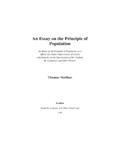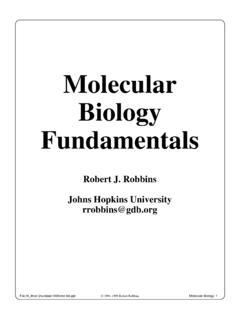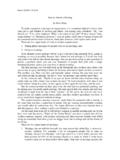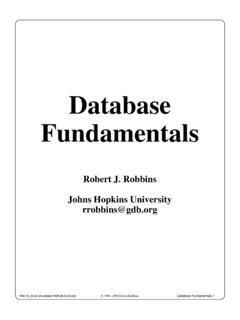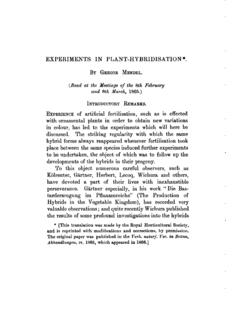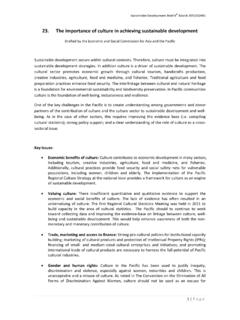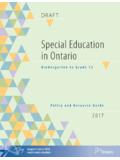Transcription of E PLANT HYBRIDIZATION (1865)
1 EXPERIMENTS IN PLANT HYBRIDIZATION (1865)GREGOR MENDELRead at the February 8th, and March 8th, 1865, meetingsof the Br nn Natural History SocietyMendel, Gregor. 1866. Versuche ber Plflanzenhybriden. Verhand-lungen des naturforschenden Vereines in Br nn, Bd. IV f r das Jahr1865, Abhandlungen, 3 s paper was first translated into English by WilliamBateson in 1901. This present version derives from the Batesontranslation, with some minor corrections and changes provided byRoger Blumberg as part of the MendelWeb project. A fewadditional corrections have been made in this version.
2 For anannotated copy, which includes comments on the Batesontranslation and Blumberg's corrections, see the MendelWeb site:( ). 1996, Electronic Scholarly Publishing electronic edition is made freely available for scholarly oreducational purposes, provided that this copyright notice isincluded. The manuscript may not be reprinted or redistributed forcommercial purposes without permission. 1996, Electronic Scholarly Publishing ProjectThis electronic edition is made freely available for scholarly or educational purposes,provided that this copyright notice is included. The manuscript may not be reprinted orredistributed for commercial purposes without , Gregor.
3 1866. Versuche ber des naturforschenden Ver-eines in Br nn,Bd. IV f r das Jahr 1865, Abhand-lungen, 3 IN PLANT HYBRIDIZATION (1865)GREGOR MENDELRead at the February 8th, and March 8th, 1865, meetingsof the Br nn Natural History SocietyINTRODUCTORY REMARKSEXPERIENCE OF ARTIFICIAL FERTILIZATION, such as is effected withornamental plants in order to obtain new variations in color, has led tothe experiments which will here be discussed. The striking regularitywith which the same hybrid forms always reappeared wheneverfertilization took place between the same species induced furtherexperiments to be undertaken, the object of which was to follow upthe developments of the hybrids in their this object numerous careful observers, such as K lreuter,G rtner, Herbert, Lecoq, Wichura and others, have devoted a part oftheir lives with inexhaustible perseverance.
4 G rtner especially in hiswork Die Bastarderzeugung im Pflanzenreiche [The Production ofHybrids in the Vegetable Kingdom], has recorded very valuableobservations; and quite recently Wichura published the results ofsome profound investigations into the hybrids of the Willow. That, sofar, no generally applicable law governing the formation anddevelopment of hybrids has been successfully formulated can hardlybe wondered at by anyone who is acquainted with the extent of thetask, and can appreciate the difficulties with which experiments ofthis class have to contend.
5 A final decision can only be arrived atwhen we shall have before us the results of detailed experiments madeon plants belonging to the most diverse MENDEL (1865)ESP FOUNDATIONS SERIEST hose who survey the work done in this department will arrive atthe conviction that among all the numerous experiments made, notone has been carried out to such an extent and in such a way as tomake it possible to determine the number of different forms underwhich the offspring of the hybrids appear, or to arrange these formswith certainty according to their separate generations, or definitely toascertain their statistical requires indeed some courage to undertake a labor of such far reaching extent.
6 This appears, however, to be the only right way bywhich we can finally reach the solution of a question the importanceof which cannot be overestimated in connection with the history of theevolution of organic paper now presented records the results of such a detailedexperiment. This experiment was practically confined to a small plantgroup, and is now, after eight years pursuit, concluded in allessentials. Whether the plan upon which the separate experimentswere conducted and carried out was the best suited to attain thedesired end is left to the friendly decision of the OF THE EXPERIMENTAL PLANTSThe value and utility of any experiment are determined by thefitness of the material to the purpose for which it is used.
7 And thus inthe case before us it cannot be immaterial what plants are subjected toexperiment and in what manner such experiment is selection of the PLANT group which shall serve for experimentsof this kind must be made with all possible care if it be desired toavoid from the outset every risk of questionable experimental plants must necessarily:1. Possess constant differentiating characteristics2. The hybrids of such plants must, during the floweringperiod, be protected from the influence of all foreignpollen, or be easily capable of such hybrids and their offspring should suffer no markeddisturbance in their fertility in the successive impregnation by foreign pollen, if it occurred duringthe experiments and were not recognized, would lead to entirelyerroneous conclusions.
8 Reduced fertility or entire sterility of certainforms, such as occurs in the offspring of many hybrids, would renderVersuche ber Plflanzenhybriden3 CLASSICAL GENETICSthe experiments very difficult or entirely frustrate them. In order todiscover the relations in which the hybrid forms stand towards eachother and also towards their progenitors it appears to be necessary thatall member of the series developed in each successive generationsshould be, without exception, subjected to the very outset special attention was devoted to theLeguminosae on account of their peculiar floral which were made with several members of this familyled to the result that the genus Pisum was found to possess thenecessary thoroughly distinct forms of this genus possess characterswhich are constant, and easily and certainly recognizable, and whentheir hybrids are mutually crossed they yield perfectly fertile , a disturbance through foreign pollen cannot easily occur.
9 Since the fertilizing organs are closely packed inside the keel and theanthers burst within the bud, so that the stigma becomes covered withpollen even before the flower opens. This circumstance is especiallyimportant. As additional advantages worth mentioning, there may becited the easy culture of these plants in the open ground and in pots,and also their relatively short period of growth. Artificial fertilizationis certainly a somewhat elaborate process, but nearly always this purpose the bud is opened before it is perfectly developed, thekeel is removed, and each stamen carefully extracted by means offorceps, after which the stigma can at once be dusted over with theforeign all, thirty four more or less distinct varieties of Peas wereobtained from several seedsmen and subjected to a two year s trial.
10 Inthe case of one variety there were noticed, among a larger number ofplants all alike, a few forms which were markedly different. These,however, did not vary in the following year, and agreed entirely withanother variety obtained from the same seedsman; the seeds weretherefore doubtless merely accidentally mixed. All the other varietiesyielded perfectly constant and similar offspring; at any rate, noessential difference was observed during two trial years. Forfertilization twenty two of these were selected and cultivated duringthe whole period of the experiments.
